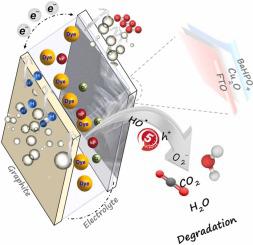Journal of Alloys and Compounds ( IF 6.2 ) Pub Date : 2023-06-02 , DOI: 10.1016/j.jallcom.2023.170822 Ayoub Ahdour , Elhassan Amaterz , Aziz Taoufyq , Latifa Aneflous , Bahcine Bakiz , Khadija Abouabassi , Ahmed Ihlal , Abdeljalil Benlhachemi

|
A highly active Cu2O/BaHPO4 photoanode was obtained using a simple two-step electrodeposition technique. The synthesised material was characterised by various methods, including X-ray diffraction (XRD), which revealed the orthorhombic phase of BaHPO4 and the cubic phase of Cu2O, while scanning electron microscopy coupled to energy dispersive X-ray spectroscopy (SEM-EDX) showed the platelet and prism morphology of BaHPO4 and Cu2O, respectively. The optical features of both compounds as well as their band gap energies were also evaluated and calculated using diffuse reflection spectroscopy (DRS). The vibrational properties of the photoanode were studied using Fourier transform infrared (FT-IR). The electrocatalytic activity (EC) of the samples were evaluated using a central composite design for surface response methodology (CCD-RSM) to determine the optimal conditions for Rhodamine B (RhB) degradation. The photoelectrocatalytic performance (PEC) of the Cu2O/BaHPO4 photoanode was about 98% in 5 min of reaction under visible irradiation, which was higher than BaHPO4 and Cu2O alone significating a quick separation of photoexcited carriers thanks to the excellent synergetic properties exhibited by the composite. This finding was corroborated by the results obtained from electrochemical impedance spectroscopy (EIS) and Mott-Schottky (MS) analysis. Various cationic and anionic dyes could be efficiently degraded. In addition, after 8 cycles, a non-significant decrease in the degradation rate was observed confirming the high cyclability of the photoanode. Therefore, Cu2O/BaHPO4 can be considered as a promising candidate for the efficient degradation of organic pollutants.
中文翻译:

使用新型 Cu2O/BaHPO4 基光电极增强可见光照射下有机染料的电化学和光电化学降解
使用简单的两步电沉积技术获得了高活性的 Cu 2 O/BaHPO 4光阳极。合成材料通过多种方法表征,包括 X 射线衍射 (XRD),揭示了 BaHPO 4的正交相和 Cu 2 O的立方相,同时扫描电子显微镜结合能量色散 X 射线光谱 (SEM- EDX)显示了BaHPO 4和Cu 2的片晶和棱柱形貌分别哦。还使用漫反射光谱 (DRS) 评估和计算了这两种化合物的光学特征及其带隙能量。使用傅里叶变换红外 (FT-IR) 研究了光电阳极的振动特性。使用中心复合设计表面响应方法 (CCD-RSM) 评估样品的电催化活性 (EC),以确定罗丹明 B (RhB) 降解的最佳条件。Cu 2 O/BaHPO 4光阳极的光电催化性能(PEC)在可见光照射下反应5分钟内约为98% ,高于BaHPO 4和Cu 2由于复合材料表现出的优异协同性能,单独的 O 意味着光激发载流子的快速分离。从电化学阻抗谱 (EIS) 和莫特-肖特基 (MS) 分析获得的结果证实了这一发现。可以有效降解各种阳离子和阴离子染料。此外,在 8 个循环后,观察到降解率的非显着降低证实了光电阳极的高循环能力。因此,Cu 2 O/BaHPO 4可被视为高效降解有机污染物的有前途的候选者。



























 京公网安备 11010802027423号
京公网安备 11010802027423号